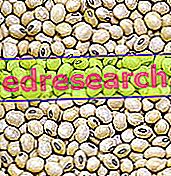See also: soy milk; soy isoflavones; soy lecithin; soy meatballs; soybean oil; seitan; soy in herbal medicine
Common name: Soy
Scientific name: Glycine max
Family: Fabaceae or leguminous
Soy is an annual herbaceous plant that can reach 80-100 cm in height. It has an erect habit, more or less bushy, is covered with bristly hairs, hence the original name of bristly soy. It has composite trifoliate leaves, small flowers, papylated, from white to red to purple depending on the variety; the fruit is a violet colored pod containing from 1 to 5 light yellow or dark seeds depending on the variety.
The part used is the seeds, which contain a high amount of proteins, polyunsaturated lipids and glucosides which include isoflavones and saponins.

Plant native to the Far East (Manchuria), cultivated for 5000 years in China, soy arrives in the West between 800 and 900. It becomes the leading product in US agriculture during the Second World War.
Cultivated on a large scale in China, Japan and Indochina today also in South America and the United States where the most productive varieties have been genetically manipulated so as to obtain a qualitatively and quantitatively excellent product (GMO). The culture of soya has also spread to some European countries such as Italy, where by law there are no cultivations of genetically modified soya.
NUTRITIONAL VALUES:
Soy is a legume like beans, chickpeas or lentils, and like all legumes it is rich in B vitamins, iron and potassium. Unlike the other legumes, however, soy is more digestible and rich in proteins and lipids (monounsaturated, polyunsaturated and phospholipids such as lecithin). Soy proteins have a fairly good amino acid profile with a biological value of less than 75, and a protein efficiency ratio of 2.1.
The interest in the beneficial properties of soy began when some epidemiological studies conducted on Asian populations revealed a lower incidence of some cancers such as breast cancer (see: Diet and cancer), colon and prostate. It was also observed that Eastern women had a more serene menopause than Western women and the risk of osteoporosis and cardiovascular disease was reduced. Therefore, the existence of a relationship between soy consumption and reduced incidence of these disorders and pathologies was hypothesized. To confirm this hypothesis, numerous studies were carried out which are still carried out with insistence to discover new properties and evaluate their positive effects on health.
The alleged beneficial effects of soy are linked to the presence of phytoestrogens (natural substances contained in plants with estrogen-like action) and isoflavones (substances very effective in counteracting menopausal disorders). To be absorbed, isoflavones must be converted into aglycones (daidzein and genistein) by the intestinal bacterial flora. Once absorbed these substances are reworked by the liver which metabolizes them producing derivatives with estrogenic activity.
In phytotherapy these characteristics are exploited to mitigate the climacteric syndrome (set of physical disorders associated with menopause such as hot flushes, insomnia, palpitation, osteoporosis and vaginal dryness). These substances have also been shown to be effective in calming emotional disorders by reducing anxiety, irritability, depression and humoral instability. Soy also protects the female body from cardiovascular diseases by lowering blood pressure and cholesterol, improving the elasticity of the arteries and fighting free radicals. Unfortunately, all these beneficial effects are still awaiting confirmation, and many researchers warn of excessive enthusiasm for soy; at high doses, in fact, food products and supplement supplements could not only prove ineffective, but even dangerous to health. Soy can speak great good or great evil, it always depends on the literature examined, composed of many favorable studies but also many others clearly opposed to its consumption for curative / preventive purposes.
In the nutritional field from soybean seeds, very rich in proteins and unsaturated fats, many products are obtained such as: milk, tofu, miso, oil, flour and flakes, soy lecithin, soy bread, soy meat, tamari and shoyu.
Soy lecithin is a natural substance that was first isolated from egg yolk in 1850 by Maurice Gobley. Lecithin has a very complex chemical composition and its emulsifying properties allow it to form a suspension of cholesterol in the blood significantly decreasing the risk of atherosclerosis, infarction and cerebral stroke.
Lecithin is also used in the food industry as an emulsifier and flavor enhancer (ice cream, biscuits, confectionery, etc.) and in the industrial field as an ingredient for the production of ecological paints and diesel. Soy proteins are also added to some cured meats to increase the protein content, organoleptic qualities and to extend storage times. In bakery products the addition of soy flour improves nutritional values by increasing the fiber and protein content.
Particular uses of soy lecithin occur in the petroleum products industry and in the pharmaceutical industry, for the production of specialties for the treatment of diseases of the liver, heart, nervous system, metabolism, lipids and in many other cases. Lecithins are in fact a source of organic phosphorus and choline.
In the cosmetic field, different substances contained in soy are used. In addition to being particularly effective in lowering cholesterol, polyunsaturated fatty acids improve skin trophism and elasticity. Soybean oil is used to produce soaps and cosmetic products in association with avocado.



